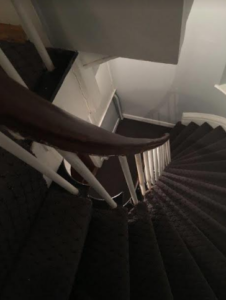According to the National Safety Council statistics, falls are the second leading cause of accidents in the U.S., second only to motor vehicle accidents. While many falls occur as the result of a “slippery” floor, many falls also occur on stairways, both within the home and in commercial locations.
While a typical stairway may seem simple in design and construction, it is important to note that there is much more to a properly designed and constructed stairway than meets the eye. Some of the more obvious design and safety criteria involve proper structural integrity, adequate lighting and the existence of handrails. Some of the less obvious design criteria necessary for the safe design and construction of a stairway are things such as dimensional uniformity.
For example, by simply looking at a stairway it is difficult to tell if the dimensions of each step are uniform, and therefore the stairway may look properly constructed to the naked eye, when in fact some defects may exist. Dimensional uniformity within a stairway is a critical design and safety necessity. In fact, building codes require that the variation in riser height (height of each individual step) and/or tread depth (width of each step) does not exceed 3/8” throughout the entire flight of stairs.
If the height of the risers or the depth of the treads vary by more than that allowed by codes, the concern is that the gait of the pedestrian will be thrown off, causing a loss of balance and a potential fall. For example, when descending a stairway if the foot becomes accustomed to landing on each stair tread at a distance of 7” down from the preceding step, and then suddenly encounters a step that is 7 3/4” down, the human dynamic of the pedestrian can be thrown off and cause the pedestrian to lose their balance and fall. The opposite is also true, if the foot comes in contact with the next stair tread too soon, it can have a similar effect. For this reason, maintaining dimensional uniformity within a stairway is critically important.
Aside from dimensional uniformity, there are many other factors involved in the proper design, construction and maintenance of a stairway. These factors include, but are not necessarily limited to the following;
- Structural integrity; maintenance of the structural integrity of the stair structure is critical to its safety.
- Handrails and guardrails; typically two handrails are required for commercial locations, the number of required handrails can also vary based on the overall width of the stairway and occupancy load of the building. Handrails must be strong enough to resist a concentrated load of at least 200 lbs. and must be located within 34” to 38” measured vertically above the leading edge of the stair treads.
- Slip resistant tread materials; the coefficient of friction, measured both wet and dry, are important to the safety of the stairway in the prevention of slipping on the stair treads. Although codes do not specifically identify a coefficient of friction measurement as an actual number, however codes do state that “non-skid” or “anti-slip” surfaces be used on stair treads.
- Proper lighting; typically one to five foot-candles of lighting is sufficient for illuminating a stairway depending on the use of the stairway (residential, industrial, etc.). Proper placement of light fixtures for the prevention of creating shadows is also important.
- Snow and ice removal; importantly, some housing codes require the tenant to clear their own stairway of snow and ice, particularly if the stairway serves the individuals apartment only.
- Visual cues as to the existence of a stairway or step; often times stair treads are covered with the same flooring materials as the adjacent floors, thus causing the stairway to visually “disappear” and blend in with adjacent walking surfaces. Visual cues include a contrasting “stripe” along the leading edge of the stair tread or landing, the use of a different type of material, etc.
- Proper stairway width related to the use group and occupancy load of the building or space the stairway serves.
There are many other codes and standards that apply to the proper design, construction and maintenance of a stairway. These codes relate to different types of stairways as well, such as spiral stairs, alternating tread stairs and winder stairs to name a few. For this reason, it is always important to consult with a building code expert witness, who considers himself a stairway expert and is familiar not only with the proper construction techniques of a stairway, but someone who is also familiar with the building codes and standards related to the specific stairway that is being investigated. Often times, a building code expert is someone with expertise in architectural, building, construction, design and engineering. A construction expert, such as a contractor, is often times a suitable candidate for stairway and building code related accidents.

